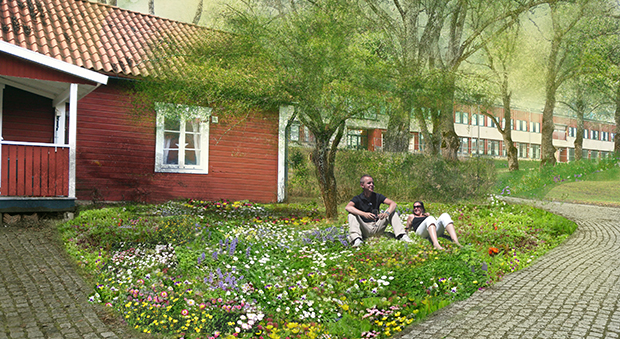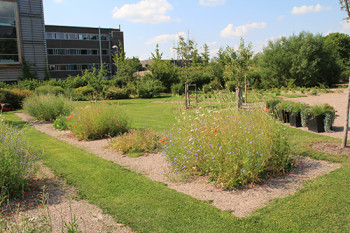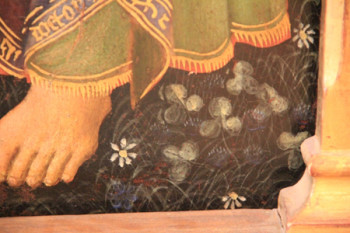
The final year of the three year project is intended for critical evaluation of existing design, establishment and management practices of conventional lawns in Swedish cities and their economic, social and environmental effectiveness. We have also decided to analyse existing European sustainable alternatives to conventional lawns. The economic and environmental benefits of such alternative lawns have been actively discussed in recent years. We found that by the end of the 20th century it was Britain, the cradle of the lawn, that offered a cardinal change in the judgement of the traditional lawn. British landscape architects James Hitchmough and Nigel Dunnett initiated a movement to create “naturalistic” (established from biodiverse mixtures of different native or exotic grass and herbaceous species) and “pictorial” meadows (made from annual decorative flowering plants which are also attractive for pollinators). British horticulturist Lionel Smith came with the idea of “grass free lawn” which is made by using specific mowing tolerant plants instead of grass. In other words, the proposed perennial grass free communities mowed only a few times a season, expelled the principle of the “snobbish” English green “carpet”.
We have also visited the Swedish firm “Pratensis” a pioneer in promoting the use of biodiverse alternative solutions for lawns and growing seed mixtures only from natural sources. They collect seed material only from Swedish native plant communities. Unlike the British who promote a more “pictorial” approach of using exotic colorful herbaceous plant material (for example from American prairie, South Africa or Asian grasslands) because of people’s “love” for color, the Swedish alternative approach to conventional lawns is grounded on local plants that are extremely cost-efficient and sustainable in the northern climate.

The first year with the lawn trial with its alternatives to traditional lawns. Tis first season only the annuals are blooming. Ultuna kunskapspark, juli 2014.
Foto: Maria Ignatieva
Inspired by all these examples we created the Experimental Alternative Lawn Trial in Ultuna Kunskapspark (Knowledge Park of SLU, Uppsala Campus) as an important educational facility for academics and public communities. Here visitors can see alternative lawn solutions. We created different plots (Grass free lawn, Bumblebees paradise, Chalky meadow, Gravel lawn, Grass free meadow, Dry meadow, Pictorial meadow and Butterly paradise).
One of the most successful was the grass free lawn with brunört, röllika, trift, liten blålocka, backnejka, femfingerört, gullviva, backtimjan, smultron, axveronika, styvmorsviol and tusensköna. It was one of the most unusual types for visitors since it was difficult to imagine walking on the flower carpet without damaging beautiful flowers. No one could believe that biodiverse grass free lawns are much older than our conventional lawns and originate in medieval time. In the 12th -15th centuries, pieces of natural meadows full of flowering plants were simply cut and transported to monasteries or castle gardens.
Another of the demonstration plots called the ”Bumblebees paradise” is using a mixture of species which are attractive for bumblebees for example: klätt, färgkulla, rödklint, blåeld, gulmåra, myskmalva, kungsmynta, åkervädd, prästkrage, backglimm, mörkt kungsljus. Among others it is important to mention the Gravel Lawn, which was established on the toughest soil with a lot of gravel. Plants such as rotfibba, blåmunkar, bergsyra, harklöver, axveronika, ärenpris, tjärblomster, kattfot were very successful here. The Clover Lawn goal was to retrieve the interest of using clover as an important biodiverse species in urban environment.
Our practical trial relies heavily on active participation and consultation within the focus and stakeholder groups and is based on exchange of scientific and practical information from leading European scientists and Swedish practitioners working with sustainable lawns.

In Medieval era in monasteries and castles gardens the cut turf from meadows were mostly likely used. Fragment of painting of St. Mary with saints. Antonio Alberti da Ferrara (1400-1449). Palazzo Dukale. Urbino, Italy.
Foto: Maria Ignatieva
The final stage of our Lawn project will result in suggestions of different practical design solutions for planning, design and establishment techniques, as well as management schemes for different types of lawns. We will deliver the results directly to stakeholders by providing an urban greening manual, demonstration sites and different management packages for municipalities and communities with recommendations on how to design, establish and manage sustainable biodiverse lawns.
